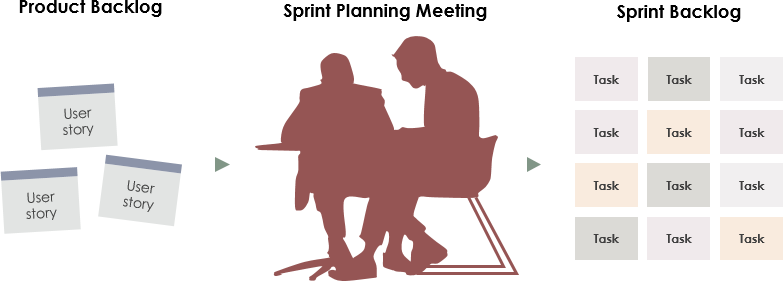Navigating the Agile Landscape: Product Backlog, Sprint Planning, and Sprint Backlog
Introduction
In the dynamic world of Agile development, effective planning and prioritization are the cornerstones of success. Three crucial elements in this process are the Product Backlog, Sprint Planning Meetings, and Sprint Backlog. Let’s explore how these components interconnect and when they come into play in the Agile development process.

Product Backlog: The Starting Line
The Agile journey begins with the Product Backlog, a dynamic and evolving list of features, enhancements, and fixes that constitute the project’s roadmap. Owned by the Product Owner, the Product Backlog is a living document that captures the vision for the product.
When does it take place? The Product Backlog is an ongoing artifact that is continuously refined and reprioritized throughout the development lifecycle. It is the central repository for all ideas, requirements, and feedback from stakeholders.
Who is involved? The Product Owner takes the lead in maintaining and refining the Product Backlog. Collaboration with stakeholders, customers, and the development team is crucial to ensure that the backlog accurately reflects the evolving needs of the project.
Sprint Planning Meeting: Charting the Course
With a well-groomed Product Backlog in hand, the team embarks on the Sprint Planning Meeting. This collaborative session involves the entire Scrum Team—Product Owner, Scrum Master, and Development Team.
When does it take place? Sprint Planning occurs at the beginning of each sprint, a time-boxed iteration usually lasting two to four weeks. The frequency of Sprint Planning ensures adaptability to changing requirements and allows the team to continuously deliver increments of value.
Who is involved?
- Product Owner: Shares the prioritized Product Backlog items and clarifies any doubts the team might have.
- Scrum Master: Ensures that the Scrum process is followed and facilitates the meeting.
- Development Team: Discusses the feasibility of selected Product Backlog items and commits to delivering a potentially shippable increment by the end of the sprint.
Sprint Backlog: The Sprint’s Blueprint
As a result of the Sprint Planning Meeting, the team creates the Sprint Backlog—a detailed plan outlining the tasks and activities required to deliver the committed increment. It serves as a blueprint for the team’s work during the sprint.
When does it take place? The Sprint Backlog is developed during the Sprint Planning Meeting and is continually refined throughout the sprint as the team gains more insights.
Who is involved? The entire Development Team is involved in creating and updating the Sprint Backlog. The Scrum Master ensures that the team adheres to the agreed-upon plan, and the Product Owner remains available for clarifications and adjustments.
The Relationships between Product Backlog, Sprint Planning Meeting, and Sprint Backlog
Here’s a table summarizing the relationships between Product Backlog, Sprint Planning Meeting, and Sprint Backlog:
| Aspect | Product Backlog | Sprint Planning Meeting | Sprint Backlog |
|---|---|---|---|
| Timing | Ongoing, continuously refined | At the beginning of each sprint | Throughout the sprint, continually refined |
| Ownership | Product Owner | Product Owner, Scrum Master, Development Team | Development Team, with oversight from Scrum Master |
| Purpose | Capture product vision and requirements | Plan the work for the upcoming sprint | Detailed plan for tasks and activities in the sprint |
| Involvement | Product Owner, stakeholders, customers | Entire Scrum Team | Entire Development Team, with support from Scrum Master |
| Focus | Long-term vision and high-level priorities | Short-term goals and commitments for the sprint | Execution of tasks to achieve the committed increment |
| Flexibility | Highly flexible and subject to continuous refinement | Adaptations can be made based on feedback | Adjustments are made based on the team’s progress |
This table provides a concise overview of the key aspects of each element and how they relate to each other in the Agile development process.
Conclusion
In the Agile development process, the seamless integration of the Product Backlog, Sprint Planning Meetings, and Sprint Backlog is essential for delivering value incrementally and iteratively. These artifacts and ceremonies ensure that the team remains adaptable, customer-focused, and aligned with the overall vision for the product. As each sprint unfolds, the collaboration and commitment of the Scrum Team propel the project forward, ultimately leading to a successful and customer-satisfying outcome.

